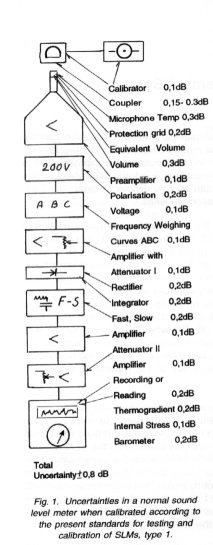
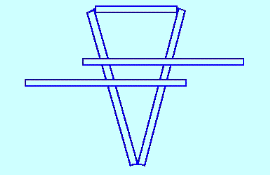
Brüel Acoustics
Precision Noise Measurement System
Dr. techn. Per V. Brüel
For aircraft noise certification it is necessary to measure the noise with the utmost accuracy. High precision noise measurement is sometimes also required for noise certification of cars, trucks, household equipment and in many other places where a specified noise limit is in force. If the product has a noise emission close to the limit, it can be very difficult to determine if the noise is actually over or under the prescribed limits.
Using the utmost care in measuring the noise with a laboratory calibrated SLM, maintained in accordance with IEC 651 standard (ref. 1) or the new IEC 1672 standard, the highest precision which can be obtained is ± 0.8 dB. In addition, many other uncertainties arise from the measurement conditions, such as reflecting floors and walls. All of the standards for certification describe the measurement conditions very carefully as regards weather, barometric pressure, temperature, humidity, reflecting and absorbing surfaces or bodies. The wisdom of all these rules can be debated since nobody can hear the difference in a sound level of 1-2 dB. But when rules exist, our job is to prove that the noise at a particular place is below the limit. If the product is close to the required limit, it can have severe consequences if the noise does not fulfil the prescribed limits. The accuracy of the measuring equipment therefore becomes critical.

Today, many certification authorities believe that they measure with an uncertainty of ± 1 dB. For instance in Switzerland, where every car is measured in accordance with the ISO standard, no car is allowed to produce more than max. 80 dBA Slow. The practice until now has been that if the SLM showed less than 81 dB, the car was approved. In other words the uncertainty benefits the manufacturer. The manufacturer has in fact no interest in very precise measurements. But now the "Green" lobby insists that since the limit is 80 dB and you cannot measure better than ± 1 dB, all cars exhibiting levels of more than 79 dB should be rejected. BA has now developed a measuring system through which it is possible to reduce the uncertainty to ± 0.3 dB.
Today we measure sound pressure in a way that is different from that used for other physical measurements. When we measure a length, we take a calibrated and scaled metric rule ? using the scale to compare a known length with the unknown length. The same happens when we measure a mass; using a weighing-scale we compare a known mass with an unknown mass. We call both the metric rule and the calibrated mass "secondary standards" since these are in tum calibrated using a primary length or mass with an accuracy ten times higher than that needed for the secondary length and mass.
When we measure sound pressure, we calibrate the SLM in a laboratory where it is calibrated using a very accurate sound pressure in a coupler. The standard laboratory uses a coupler which can accommodate several different SLMs and in this procedure ± 0.2 dB is lost. The sound pressure itself can be established within ± 0.02 dB. The laboratory checks many other things, but in particular the A- and C-weighting curves and the attenuator are of primary interest. Fig. 1 shows all the elements of a SLM which contribute to the final uncertainty. When the SLM has been calibrated in the standard laboratory, it is located at the user?s premises, sometimes for several months. From here it is taken to the place where the measurement is performed. When all the uncertainties are summed, and the Euclidean norm is used, the result is that the best we can do is ± 0.8 dB. At the measurement location, the entire system is normally checked using a small sound calibrator to see if the whole system works at all.
Most of the sound calibrators on the market are not better than the SLM itself. The reason for this is that most of the calibrators refer to a small microphone. Those that use a precision condenser microphone for regulating the internal sound pressure use a frequency of 1000 Hz as reference and this causes difficulties. The advantage of using 1 KHz as the reference frequency is that at 1000 Hz all the weighting curves cross. But for other reasons it is a doubtful choice.
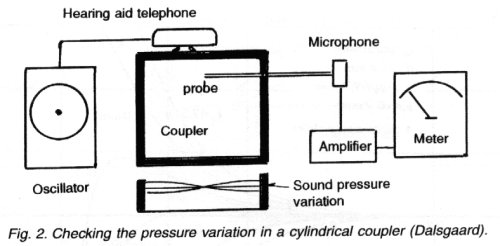
1 KHz is not in the mid-band (on a log-scale) of industrial noise or noise from traffic and aircraft. All of these types of noise are normally most dominant in the range from 50 Hz to 2 KHz. The mid-point is 250 Hz. Naturally, it is not so important which frequency we use as reference frequency, but it is satisfactory to use a frequency in the middle of the most important frequency range. More important is the fact that by using 1000 Hz as a reference, we are approaching the limit for the volume of the couplers that we use for transfer of sound pressure to microphone and from microphone to sound pressure. The late Dalsgaard Christensen in Odense, Denmark (ref. 2) made some measurements of the pressure deviation in different couplers 40 years ago and found that a measurable difference was found if the largest dimension of the coupler was more than 1/20 of the wavelength. The measurement principle is shown in fig. 2. At 1000 Hz 1/20 of the wavelength is 17 mm. In a cylindrical coupler it is possible to have the axial motion to partly compensate for the cylindrical motion at the point of the microphone (see ref. 2). Fig. 3 shows an example of pressure distribution in a standard 20 cm3 coupler. Unfortunately this balancing of two motions cannot be used in our pistonphone, which also has around 20 cm3 volume. In our coupler the piston is small compared to a microphone and placed unevenly.
We have therefore to calculate for the worst case. As can be seen in fig. 3, at 1 KHz there are variations of up to 0.04 dB, whereas at 250 Hz the variations in pressure over the volume are less than 0.01 dB. Therefore 250 Hz is a good choice as a reference where the volume can be 20 cm3.
By far the best pistonphone ever built is B&K Type 4220 and 4228 (ref. 3) which both operate at 250 Hz. Some of the difficulties with the B&K pistonphone are that it can be used for different SLMs and that it is tricky to hold on a SLM without mechanical stress at the microphone resulting in either a bending force or variable pressure. Both have some influence on the microphone sensitivity. The disadvantage is taken care of by modifying the B&K Pistonphone 4228 with a new coupler which eliminates these problems. Brüel Acoustics also increases the guaranteed accuracy by only making the measurements in a limited temperature range from 12° to 35° C, which should be adequate as no-one certifies an aircraft or car outside this range.
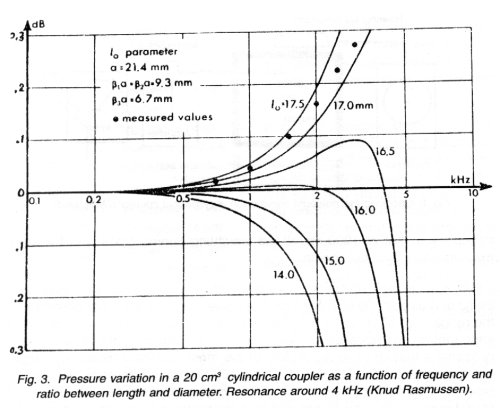
Frequency range also has to be reduced to be guaranteed only from 200 Hz to 2 KHz, a range in which we can guarantee an accuracy better than ± 0.2 dB. For frequencies below 200 Hz and above 2 KHz, we follow the tolerances in IEC 1672, but with half the required values for type 1.
Coupler volume can vary slightly and leakage can occur. Normally these are very small variations which have little influence. Since for noise evaluation we use the A-weighting curve, it will be practical, also for this reason, to guarantee accuracy from 200 Hz and upwards.
At higher frequencies there will be problems with directivity and reflections from knobs and instrument surfaces. A practical limit for the guarantee could, therefore, be 2 KHz. Changing temperature can alter the performance of the instruments in an uncontrolled way. Therefore it will be required to have the instrument at the measurement location for at least 15 minutes before measurements are made. We are also increasing accuracy by only using 1/2" condenser microphones. These microphones are the most stable ever built (ref.4). By using only one type of microphone, the microphone receptor in the couplers can be made far more accurate.
Another important step for reducing uncertainties is that we link the SLM to the precision coupler. If the SLM and coupler always are used together, we can avoid a lot of minor uncertainties during the whole procedure. It is also important that the BA pistonphone is constructed in such a way that during the calibration it is placed on the SLM without being touched by human hands. Fig. 4 shows a BA pistonphone 42BC which can be placed on the SLM during operation.
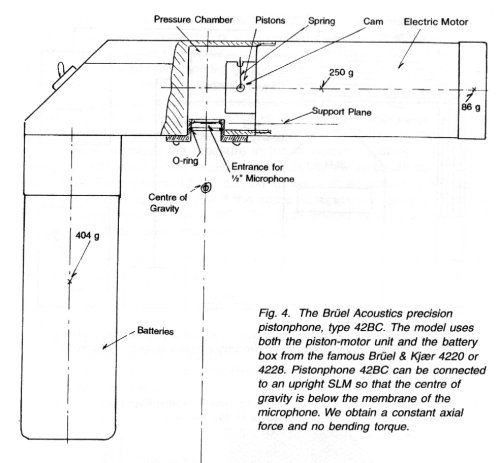
Primary Calibration
The Acoustical Laboratory at the Technical University of Denmark (DTU) in Lyngby, Denmark is run by Dr. Knud Rasmussen. This laboratory has a series of Brüel & Kjær microphones, some of which are more than 30 years old. Many of these microphones are often checked by the reciprocity method and have all the time been cross-checked by PTB, Germany, NPL, UK, and NBS, USA. These microphones are now regarded as the most accurate in the world. Brüel Acoustics has made a special coupler, type 42BD with two connections for microphones (see fig. 5). Here it is possible to measure the pressure in the coupler with Dr. Rasmussen?s 1/2" microphones. During the measurements, the customer?s SLM is inserted in the lower bushing. The reading on the SLM indicates the known pressure at the SLM?s microphone. Then the customer?s Pistonphone 42BC is mounted on the SLM. The reading is now different and indicates the pressure in the customer?s Pistonphone 42BC. Using the difference in the readings of the SLMs the absolute sound pressure in the Pistonphone 42 BC can be known with an accuracy of around ± 0.02 dB. This is only possible if the same SLM is used together with the corresponding Pistonphone 42BC. The SLM should have a resolution of around 0.01 dB to obtain maximum precision.
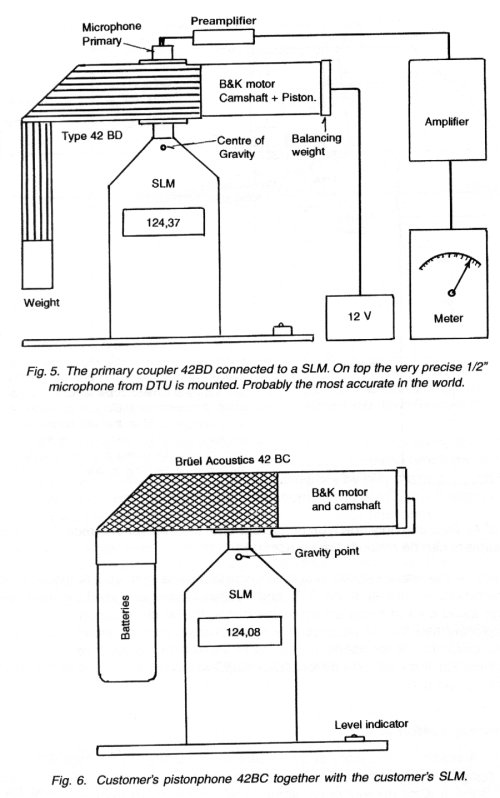
When measuring in the field, the procedure is very simple: place the SLM plus 42BC ready to make the first calibration trace.
Step 1. Wait 15 minutes so that all the equipment has the same temperature.
Step 2. Run the first calibration using C-weighting and an attenuator setting covering 125 dB.
Step 3. Make the measurement. (Normally using A-weighting curve.) Look for overloads.
Step 4. Second calibration. Remember to switch back to C-weighting and correct attenuator setting.
Step 5. Compare the two calibrations. Note temperature and most importantly, check the barometric pressure.
When comparing the two calibrations it is satisfactory and reliable to have a SLM with 0.01 dB resolution. If the calibrations before and after the measurements are very close, the measurements are also correct with extremely small tolerances.
Barometric Pressure
Any pistonphone will produce a sound pressure (SP) in the coupler proportional to the static ambient pressure. Therefore it is necessary to correct the reading relative to standard atmospheric pressure which is 1013 hPa (1013 mbar). The actual ambient pressure reading can be taken directly from a special barometer Brüel & Kjær UZ0001. Or, it can be obtained from an aircraft altimeter which normally is more accurate than the barometer. You can also call your nearest airport and ask for the actual pressure at sea level (QNH) in hPa. You must then know your present altitude above sea level either in meters or feet and make the appropriate correction for altitude.
Error in the Procedure
The primary SPL in 42BD is assumed to be known exactly within very small tolerances. The Danish Technical University?s Laboratory thinks these tolerances are better than ± 0.02 dB. We then transfer the pressure from 42BD to 42BC via the customer?s SLM. Here we may lose another 0.02 dB. The error could be inaccuracy in the microphone bushings in 42BD and 42 BC. The microphone adapters (bushings) must therefore be made very precisely. It is important that the 0-ring is placed exact, so no variations in volume occur. The fact that the centre of gravity is placed below the microphone membrane helps to make the mechanical tension on the microphone small and exactly the same in both couplers. We are sure that both the mechanical force and bending are the same in both cases as the mass and the location of the centre of gravity are the same. We will assume an uncertainty of ± 0.02 dB for this transfer. The absolute most influential uncertainties are the reading of the SLM. If we could get a robust and stable SLM with very accurate weighting curves and attenuator with 0.01 dB resolution, we could determine a sound pressure in front of the microphone with an uncertainty of less than ± 0.1 dB. Thus by moving a calibrated stable sound pressure to the field our accuracy increases dramatically from ± 0.8 dB to ± 0.3 dB.
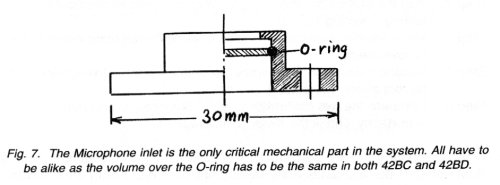
How Stable is the Pistonphone 42BC?
The only thing that can go wrong with the Pistonphone is a sticky piston. If a piston does not move at all, the SPL in the coupler drops 3 dB, but the sound is clean. If a piston moves, but sticks on the way down, the sound is not clean and an oscillograph will show a flat part on the pressure curve. Both errors are easy to detect. Temperature variances are small and can be omitted. Leak- age in the coupler is dangerous, but is checked by momentarily increasing the RPM of the motor (the sound pressure must not increase).
So all in all, the 42BC is a very stable product if it is handled with the care warranted by a very high precision instrument.
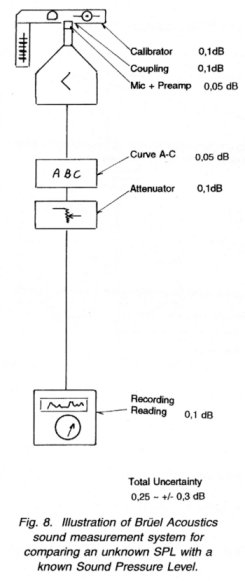
Conclusion
By measuring a sound pressure by comparing the unknown quantity with a known sound pressure, the uncertainty will decrease from ± 0.8 dB to ± 0.3 dB. The SLM should use a good 1/2" condenser microphone with a flat response. Both the attenuator and the two weighting curves, A and C, must be accurate. The rectifier must be controlled. But all the other factors ? sensitivity, long-term stability, stability with respect to varying temperature and moisture, incorrect polarisation, voltage, incorrect protection grid or an unknown equivalent volume of the microphone, etc. ? have no influence.
In other words, the SLM used could be a class 2 instrument except it should have class 0 attenuator, A and C- weighting curves and a correct rectifier. It should be equipped with a microphone with a flat frequency response curve, but it does not need to exhibit long time stability and the sensitivity does not need to be known. It will facilitate both the SP transfer in the laboratory and give peace of mind if the SLM has a resolution of 0.01 dB. With this exceptional resolution you can easily be aware of any deviation from what is expected.
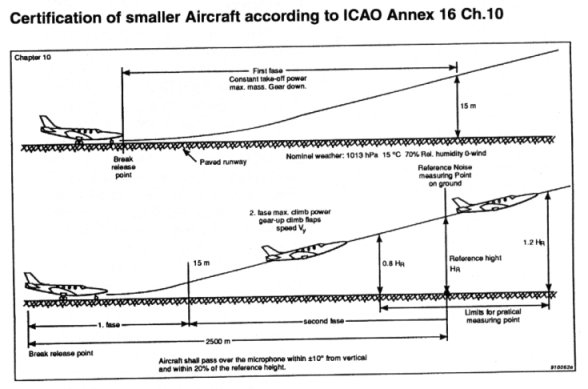
References:
[1] IEC 651 or 1672, Sound Level Meters (1979 or 1997).
[2] Knud Rasmussen: Cylindrical Couplers. Report 1 (1969), Denmark?s Technical University.
[3] Per V. Brüel, Condenser Microphones, Part 1, fig. 12, page 22, Brüel & Kjær Technical Review, no. 4, 1964.
[4] IEC 1094/1, Laboratory Standard Microphones (1992).
[5] IEC 942, Sound Calibrators (1988).
© Brüel Acoustics - from Dr. Per V. Brüel & Dr. G. Mario Mattia, Rome, Italy, august 1998.

® Web masters Mario
& Paolo Mattia - updated on April 2003, Web Master
On line from 1995 November 10